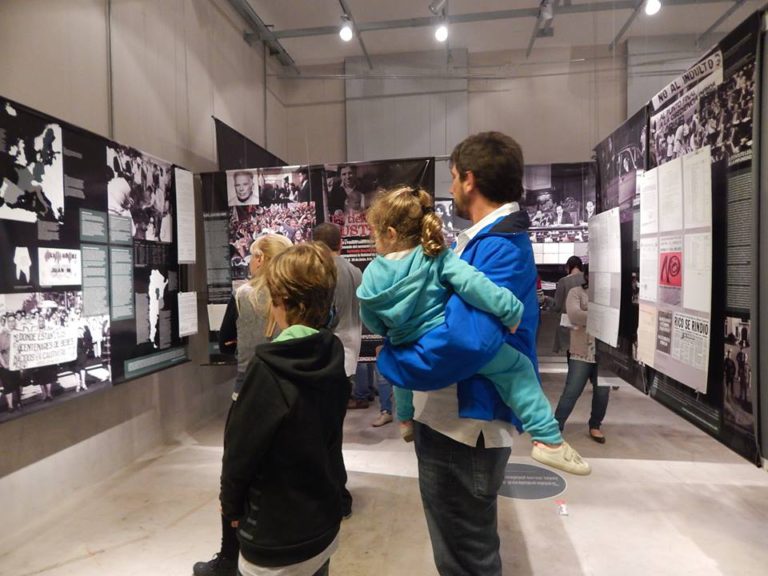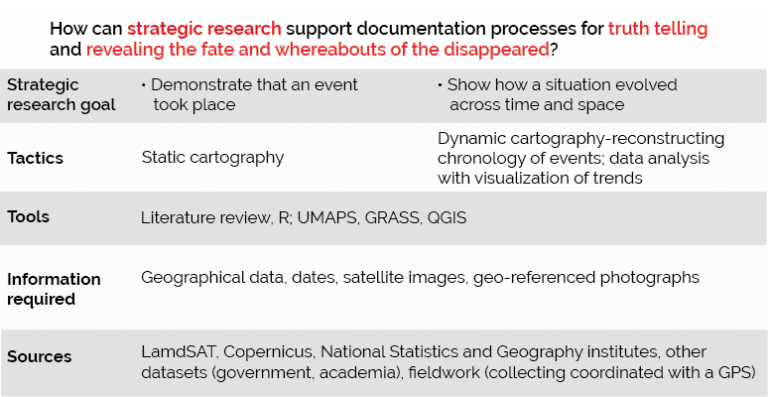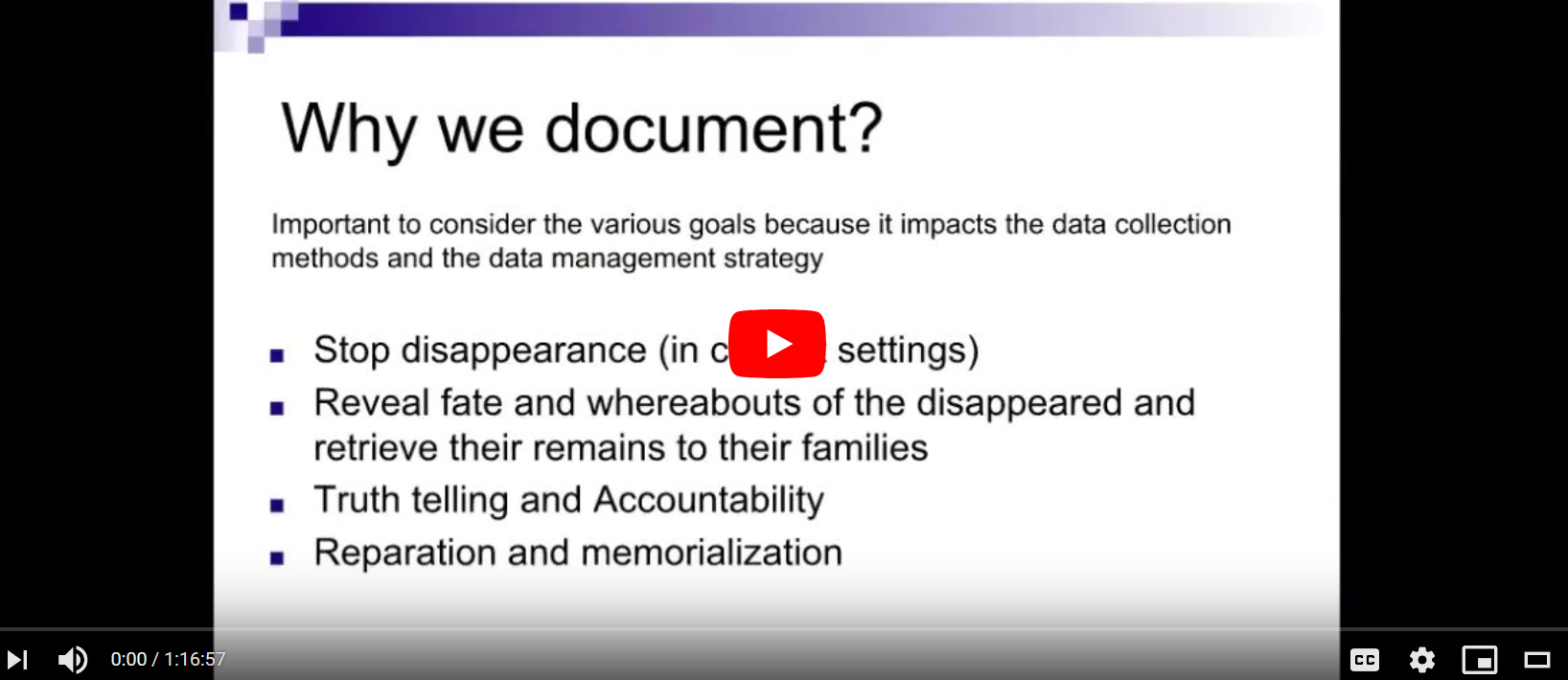Summary now available! También disponible en español.
Thank you to Justine Di Mayo (Act for the Disappeared, Lebanon), Özlem Kaya (Hafiza Merkezi, Turkey), Tamar Hayrikyan (Técnicas Rudas and Centro Diocesano de Derechos Humanos Fray Juan de Larios, Mexico), Celina Flores (Memoria Abierta, Argentina) and Jorge Ruiz Reyes (Universidad Iberoamericana Mexico city, México) for participating in the community discussion on Documenting the Disappeared, and to everyone else who joined!
From November 27th to December 8th, we co-hosted in partnership with Act for the Disappeared and Hafiza Merkezi, a space for practitioners to share their experience, considerations, resources and cases of study to learn more on how documentation, strategic research and technology can be applied to documenting enforced disappearances.
Enforced disappearance is a wide spread, global problem. It’s used to spread fear and terror throughout society. The process of documenting the disappearances can support individual families in establishing what happened to their loved ones. The preservation of this information builds collective memory. Furthermore, when systematically undertaken, documenting disappearances also helps understand who the perpetrators were/are and hold them accountable.
Summary of the discussion
This summary is organised around four goals for documenting disappearances identified through the discussion, and a set of considerations that can be helpful in different parts of the process.
Goal 1: To stop and prevent disappearance (in conflict settings)
In working towards this goal, the information collected through documentation can be used to advocate and lobby to stop disappearances, request the government to carry out investigation on the fate of missing people, denounce at national or international level through media and advocacy campaigns, and report analysis of various aspects of the disappearance.
“Gathering a list of the disappeared persons can help by showing the scale of the disappearances.”
Justine Di Mayo, Act for the Disappeared, Lebanon
Below are a few examples of how documentation efforts have been used to stop and prevent disappearances:

- On December 10th (World Human Rights Day) 2015, Hafiza Merkezi organised the poster campaign Where are they? on the streets of Istanbul to draw attention to the practice of enforced disappearance and to reiterate the demand for justice, in this case related to past crimes.
- HRDAG, Data Cívica, and the Human Rights Program at Universidad Iberoamericana created a database of clandestine graves in Mexico, based on reports by the local and national press. They compared the records with official figures to give a more accurate estimation about the magnitude of the problem in the whole country. They used the data to create a statistical model that predicts other municipalities in Mexico with high probabilities of having clandestine graves. Their documentation work is aimed at putting pressure on the government to carry out investigations on clandestine graves and to create better public programs regarding missing persons in Mexico, such as exhumation programs.
Goal 2: To reveal the fate and whereabouts of the disappeared and retrieve their remains for their families
The goal of revealing the fate and whereabouts of the disappeared can be supported by collecting information about the context of disappearances. Such as:

- Interviewing relatives of the missing people, witnesses and members of armed groups
- Collecting photos, satellite images, state and armed groups archives
- Collecting location of detention centers and checkpoints
- Collecting events related to disappearances
To support human identification it is important to document location of graves, develop a hypothesis on the identity of the missing that are buried in the graves, collecting ante and post mortem data or ante disappearance data.
“It is important to document clandestine graves findings with different sources of information. The media may observe findings that have not been observed by the official institutions and vice versa.”
Jorge Ruiz, Universidad Iberoamericana Mexico City
“We use a database and mapping to archive the data and to link the different layers of information, in order to reconstruct the itinerary of the disappeared people.”
Justine Di Mayo, Act for the Disappeared
Goal 3: Truth telling and accountability
When working towards this goal, the documentation will consist of gathering evidence to establish individual and state responsibility and support criminal prosecution, and to establish a comprehensive truth about what happened thus contributing to institutional procedures to ensure disappearances do not reoccur.
- “Documentation can help prosecutions in other countries or at the international level” Lisa Reinsberg of IJRCenter. For example, the efforts that Germany and other States are taking to seek accountability for the human rights violations committed in Syria’s conflict.
- Strategic research can be used for truth telling to demonstrate that an event took place and to show how a situation evolved across time and space. On accountability efforts it can help determine the existence of an official policy or position and to reconstruct hierarchies and power relationships.
Goal 4: Reparation and memorialisation
Documenting the life of the disappeared person contributes to recognising and restoring the dignity of victims. To guarantee non recurrence, the information can be used to develop awareness-raising tools such as archives, museums and commemorations.

- Fushat ‘Amal (Space for Hope) is a digital memorial for disappeared people in Lebanon. The website allows the families of the missing to add a case, including biographical information, information about the disappearance, photos and videos, as well as testimonies. Over 220 families of missing persons have used Fushat ‘Amal to share their story.
- Memoria Abierta in Argentina has collaborated with TV productions related to the civic-military dictatorship in Argentina. They have also produced educational resources for schools, and organised public exhibitions of their archives.
- Hafiza Merkezi’s video Holding Up the Photograph presents the testimonies of women whose husbands were forcibly disappeared. It was screened in Istanbul as part of the exhibition “Mobilizing Memory: Women Witnessing” in 2014.
Considerations when documenting disappearances
There are many considerations to take into account throughout the process of documenting disappearances. The following points were highlighted in this discussion:
- External variables: The achievement of your documentation goals can be affected by many variables such as: conflict or post conflict setting, security context, access to information, political context like a political transition or if there is political will, national judicial system function or dysfunctional, needs of the victims as it can change over time, and capacity of civil society organizations to undertake documentation work and develop a data management strategy. It is important to identify these variables as well as strategies for mitigating any negative effect on your documentation efforts.
- Define the crime you are documenting, as it states not only who you identify as perpetrators but also who is considered as a victim (direct or indirect) of enforced disappearances. You may consult the Rome Statute of the International Criminal Court or the International Convention for the Protection of All Persons from Enforced Disappearance definitions.
- Define the sources you will use. Sources may include: previous works on enforced disappearances of national or international bodies, legal documents like investigations, files, verdicts of national and international bodies, freedom of information requests, media monitoring and survivors’ testimonies.
- Manage expectations and be clear on what can be achieved in a period of time. When interviewing and working with families of the missing person, this will help you ensure effective application of the ‘do not harm’ principle.
- Understand and preserve the context of the archive, and the context in which each document was produced.
- Verification strategy: “Identify your verification strategy and be transparent about it.” Özlem Kaya, Hafiza Merkezi
- Strategic research: Documenting disappearances can be supported by strategic research. The tables below show an idea of how strategic research can help in terms of tactics and tools, but also which type of information might be required to answer such questions and examples of the sources that could provide it. (Note: The information in this table was developed by Tamar Hayrikyan. Watch the entire presentation below. Click on each table to open a larger image in another window.)

Watch the webinars
Recordings of our four webinars are embedded below. Thanks to our intern, Indira Cornelio, each video has Spanish subtitles available. (Los webinars cuentan con subtítulos en español).
How to join the discussion forum
It’s not too late to join this discussion! You can join the asynchronous discussion forum in the the HURIDOCS Collaboratory. Create an account, explore the forum and share your questions, challenges and resources. Let’s continue the conversation!
Note: The forum is open to anyone to join and read so please be careful what you share – do not share any personal identifiable information of defenders or organisations with whom you work.

